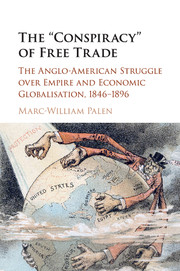Refine search
Actions for selected content:
26946 results in Economic history
Glossary
-
- Book:
- The 'Conspiracy' of Free Trade
- Published online:
- 05 February 2016
- Print publication:
- 09 February 2016, pp xiv-xiv
-
- Chapter
- Export citation
Conclusion
-
- Book:
- The 'Conspiracy' of Free Trade
- Published online:
- 05 February 2016
- Print publication:
- 09 February 2016, pp 267-279
-
- Chapter
- Export citation
7 - “A sea of fire”
-
- Book:
- The 'Conspiracy' of Free Trade
- Published online:
- 05 February 2016
- Print publication:
- 09 February 2016, pp 172-205
-
- Chapter
- Export citation
Introduction
-
- Book:
- The 'Conspiracy' of Free Trade
- Published online:
- 05 February 2016
- Print publication:
- 09 February 2016, pp xv-xxxviii
-
- Chapter
- Export citation
3 - Mobilizing free trade
-
- Book:
- The 'Conspiracy' of Free Trade
- Published online:
- 05 February 2016
- Print publication:
- 09 February 2016, pp 56-83
-
- Chapter
- Export citation
Contents
-
- Book:
- The 'Conspiracy' of Free Trade
- Published online:
- 05 February 2016
- Print publication:
- 09 February 2016, pp vii-viii
-
- Chapter
- Export citation
Copyright page
-
- Book:
- The 'Conspiracy' of Free Trade
- Published online:
- 05 February 2016
- Print publication:
- 09 February 2016, pp iv-iv
-
- Chapter
- Export citation
4 - Fighting over free trade
-
- Book:
- The 'Conspiracy' of Free Trade
- Published online:
- 05 February 2016
- Print publication:
- 09 February 2016, pp 84-115
-
- Chapter
- Export citation

The 'Conspiracy' of Free Trade
- The Anglo-American Struggle over Empire and Economic Globalisation, 1846–1896
-
- Published online:
- 05 February 2016
- Print publication:
- 09 February 2016
Innovation's Golden Triangle: Finance, Regulation, and Science at the Bell System, 1877–1940
-
- Journal:
- Business History Review / Volume 90 / Issue 2 / Summer 2016
- Published online by Cambridge University Press:
- 25 January 2016, pp. 277-299
- Print publication:
- Summer 2016
-
- Article
- Export citation
THE DYNAMICS AND DETERMINANTS OF SLAVE PRICES IN AN URBAN SETTING: SANTIAGO DE CHILE, c. 1773-1822*
-
- Journal:
- Revista de Historia Economica - Journal of Iberian and Latin American Economic History / Volume 34 / Issue 3 / December 2016
- Published online by Cambridge University Press:
- 22 January 2016, pp. 449-477
- Print publication:
- December 2016
-
- Article
- Export citation
Creating the Sociedad de Responsabilidad Limitada: The Use of Legal Flexibility in Spanish Company Law, 1869–1953
-
- Journal:
- Business History Review / Volume 90 / Issue 2 / Summer 2016
- Published online by Cambridge University Press:
- 22 January 2016, pp. 227-249
- Print publication:
- Summer 2016
-
- Article
- Export citation
7 - Transport
-
- Book:
- The Path to Sustained Growth
- Published online:
- 05 January 2016
- Print publication:
- 21 January 2016, pp 132-150
-
- Chapter
- Export citation
2 - The classical economists
-
- Book:
- The Path to Sustained Growth
- Published online:
- 05 January 2016
- Print publication:
- 21 January 2016, pp 19-30
-
- Chapter
- Export citation
Dedication
-
- Book:
- The Path to Sustained Growth
- Published online:
- 05 January 2016
- Print publication:
- 21 January 2016, pp v-vi
-
- Chapter
- Export citation
9 - The completion of the industrial revolution
-
- Book:
- The Path to Sustained Growth
- Published online:
- 05 January 2016
- Print publication:
- 21 January 2016, pp 173-197
-
- Chapter
- Export citation
1 - Organic economies
-
- Book:
- The Path to Sustained Growth
- Published online:
- 05 January 2016
- Print publication:
- 21 January 2016, pp 7-18
-
- Chapter
- Export citation
8 - England in 1831
-
- Book:
- The Path to Sustained Growth
- Published online:
- 05 January 2016
- Print publication:
- 21 January 2016, pp 151-172
-
- Chapter
- Export citation
3 - Energy consumption
-
- Book:
- The Path to Sustained Growth
- Published online:
- 05 January 2016
- Print publication:
- 21 January 2016, pp 31-44
-
- Chapter
- Export citation
Contents
-
- Book:
- The Path to Sustained Growth
- Published online:
- 05 January 2016
- Print publication:
- 21 January 2016, pp vii-vii
-
- Chapter
- Export citation
